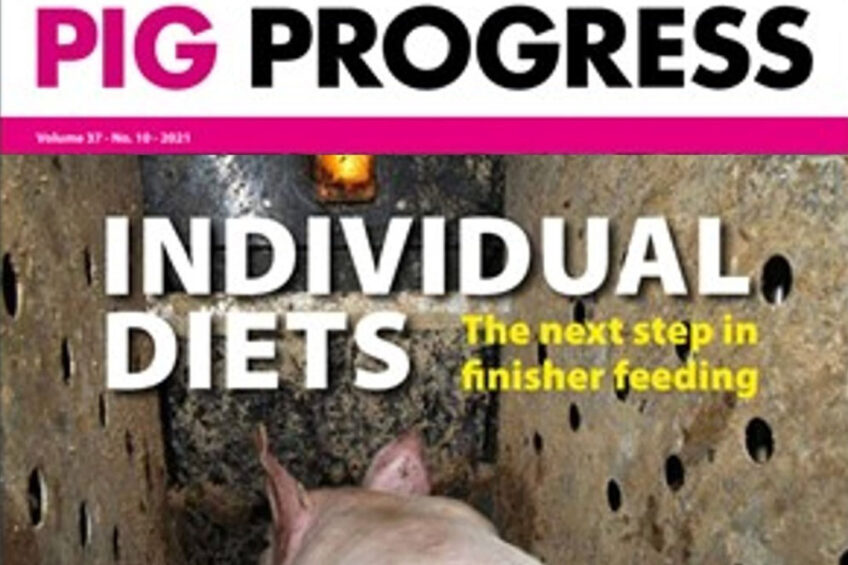Pathogens, prevention, and personal plans in Pig Progress 10

The 10th edition of Pig Progress for 2021 is now available online. This edition highlights the urgent need for more attention to be given to swine influenza. Considering the Covid-19 pandemic, veterinary virologist emphasises that the way the veterinary world keeps viruses under control is an example for human virology. Also, how can nutrition improve claw quality and weaning stress?
View Pig Progress digital magazine, edition 10
Five signs illustrating Germany’s fall
Domestic hog production, unlimited imports of raw ingredients for feed, imports of piglets and finisher pigs, and the ability to sell pig meat on international markets enabled Germany to transform from a leading importer of pig meat to the leading exporter within 3 decades. When it became a challenge to export surplus meat, economic troubles began. Professor emeritus Hans-Wilhelm Windhorst paints the picture on pages 6-8.
Family feeding: More piglets will eat prior to weaning
A research project – ‘Family Feeding Matters’ – aimed to develop an innovative feeding concept for sows and piglets that would align more closely to their natural behaviour. The innovative part of the research applied to the new feeding and drinking system and new feed type. The article on pages 10-11 investigates the results.
Column: Functional nutrition opportunities
On page 13, president of the Sunswine Group, Dr Casey Bradley, discusses functional nutrition and proposes combing the silos of data we have from production, the feed mill and veterinarian diagnostics to create a functional nutrition picture for the swine industry.
Pork from entires, without the taint, please
On pages 14-15, correspondent Philippe Caldier summarises a presentation by Patrick Chevillon at the recent edition of the Sommet de l’Elevage in France where he discusses the production and valorisation of meat from entire male pigs.
More attention needed for swine influenza
The swine influenza virus is behaving more whimsically than it did a decade ago. What is this pathogen’s impact and how can pork producers reduce the risk of infection? The article on pages 16-17 explores the answers.
Interview with veterinary virologist, Professor Hans Nauwynck
In an interview on pages 18-20, Nauwynck expresses his distaste in allegations that modern livestock farming is the cause of all pandemics, and highlights that the way the veterinary world keeps viruses under control is an example for human virology. “If the Covid-19 virus had only struck in pig farming, it probably would not have spread as fast as it does now in humans.”

An ‘ESF’ station for grow-finishers
On pages 24-26, Pig Progress editor, Vincent ter Beek, visits a French pig farm with 430 sows and a grow-finisher site 2 km down the road with 2,000 finishers. Here, pig producer Frédéric Baudet tried the Selfifeeder GFI, which is Adderva’s version of an Electronic Sow Feeding (ESF) station with built-in weighing.

Pigs: A known source of human diseases
Salmonella infections in pigs can become worse in stressed animals and so controlling stress levels in pigs has a direct impact on public health. Read more on pages 28-29.
View Pig Progress digital magazine, edition 10
Animal by-product use in feed – what’s next?
In the European Union, a 20-year ban on the use of animal by-products as feed for pigs and poultry is being lifted. By 2027, the animal protein feed ingredients market is predicted to be worth US$280 billion. On pages 31-32, correspondent, Treena Hein, looks at what this means and what might limit its use.
Nutrition for claw horn quality and integrity
The culling rate due to lameness is estimated to be up to 35%, and as sows are increasingly being kept loose during gestation, and farrowing crates are likely to disappear, pig claw quality and integrity are becoming increasingly important. How can nutrition help to improve claw quality? Read more on pages 34-35.

Tackling weaning stress with nutrition
Weaning is a stressful event, which is known to weaken the immune system. E. coli remains one of the most economically important and complex challenges in today’s global pig industry. This article found on pages 36-37 delves into what extent can nutritional solutions provide a solution.
Mycotoxins and pigs: Does low risk mean no risk?
Of all the animal species, pigs are among the most sensitive to the negative impact of unwanted toxins. While acute mycotoxicosis in pigs is relatively rare nowadays, mycotoxins may be present in low doses and can lead to subclinical health problems. This article by Alltech on pages 38-39 details the effect and management of mycotoxin challenge.
Column: Crisis management
On page 42, Irene Camerlink, an interdisciplinary researcher focusing on pig behaviour, welfare and production, brings to light the increasingly relevant need for farms to have an action plan for livestock in the event of a natural disaster or when there is a need for evacuation. She also outlines 7 steps to consider mitigating potential risks.











